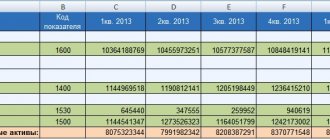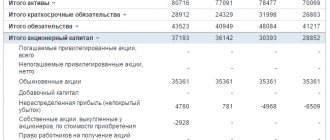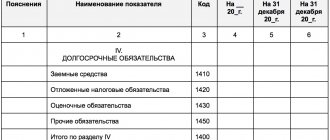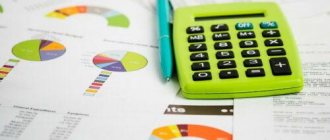Definition
Liabilities _
) are one of the three sections of the balance sheet besides assets and equity. This section reflects the company's debt obligations to its creditors that arose as a result of previous operations. By their economic essence, they, like equity capital, are a source of financing the company’s assets. In the event of default on debt obligations, creditors have the right to claim the company's assets to the extent of the outstanding debt to them.
Liabilities also include advances received that were paid for future goods, work or services. Since this amount has not yet been earned, it may be recorded as deferred income or customer deposits.
Composition of obligations
The obligations can be divided as follows:
- Related to current operations. This includes tax payments, advances and wages to employees, rent payments, payments for materials and goods supplied under the contract.
- Liabilities that are subject to liquidation within a year after the financial statements are prepared. These may be long-term obligations that must be repaid in the near future.
- Liabilities that must be settled within one year of the balance sheet. This includes payment of compensation for unused vacation, bonuses, etc.
The most common types include the following:
- Accounts payable is the amount that the debtor is obliged to pay as payment for goods delivered or services received that are necessary for the functioning of the enterprise. Its size is stipulated by the terms of the contract.
- Short-term bills are invoices for goods and services supplied that were not purchased for the main activities of the organization.
- The share of long-term debt that must be repaid in the next reporting period.
- Accrued payments. They include loan payments to the bank and employee salaries.
- Cash payments that an organization makes at the request of a creditor.
- An advance payment towards a future transaction. This also includes deposits.
- An advance payment received for a future supply of goods or for the provision of a service.
- Tax deductions to federal and local budgets.
- Debt for employee vacations (so-called estimated liabilities). Its occurrence is a consequence of the reluctance of employees to go on vacation during the reporting period.
- Dividends that must be calculated for all owners of shares and bonds of the enterprise.
Current liabilities include debts that must be repaid in the near future
Structure of liabilities in the balance sheet
Liabilities have the same classification structure as assets: current liabilities and non-current liabilities. They are reflected in the balance sheet in order of increasing due date for their payment.
Current responsibility
Current liabilities are those that must be paid within 12 months or the operating cycle if its duration is more than one year. Their occurrence is usually associated with the use of current assets (English Current Assets), the creation of another current liability or the provision of any services.
Typically this section of the balance sheet includes the following items.
- Debt to banks
. Represents the amount of short-term debt owed to banks, for example, under a bank line of credit. - Accounts payable
. This is the amount of debt owed to suppliers of products and services that were provided on credit, but the payment period for which has not yet arrived. - Salaries, rent, taxes and utilities payable
. This reflects the amounts that the company must pay to its employees, landlords, government, etc. - Accrued liabilities (accrued expenses)
. These liabilities arise because expenses are incurred in a period prior to the period in which they are paid. This item covers a wide variety of expenses, for example, advances received from clients, dividends payable, arrears of accrued wages, etc. - Bills payable (short-term loans)
. These are the amounts that the company is obliged to pay to the creditor, which usually also includes the payment of interest. - Deferred income (customer prepayments)
. These are payments received from customers for goods and services that the company has not yet provided or has not yet begun to incur any costs associated with providing them. - Dividends payable
. It arises in a situation where a company has already announced dividends, but has not yet paid them to its owners. - The current portion of long-term debt
. This item reflects the portion of long-term debt that falls due in the next 12 months. In theory, any associated premiums or discounts should also be classified as current liabilities. - Current portion of finance lease obligations
. This is part of the long-term finance lease payments that are due over the next year.
long term duties
Long-term liabilities are those that must be repaid later than 12 months or after the operating cycle, if it is longer than one year. They should be reflected as the present value of future payments.
The most common examples of long-term liabilities are.
- Bills payable (long-term loans).
This is the amount that the company is required to pay the lender, which usually includes interest. - Long-term debt (bonds payable).
This is long-term debt minus the current portion. - Deferred tax liabilities.
They arise as a result of discrepancies between accounting and tax accounting standards in the case when the amount of tax payable in accounting exceeds the amount of tax payable in tax accounting. In other words, it is the amount of tax that the company will have to pay in the future. - Employee pension plan.
This is the company's obligation to pay pension benefits to its retired and active employees. Payments from this fund begin upon the employee's retirement. This item reflects the additional amount the company must contribute to its current pension fund to meet its future pension obligations. - Long-term finance lease obligations.
Long-term liabilities of the enterprise in the balance sheet
Long-term liabilities of the enterprise in the balance sheet are represented by such elements as:
- loans and credits of the organization;
- deferred tax liabilities;
- other long-term liabilities.
All long-term loans and credits that were provided to the organization are recorded in accounting account 67 “Long-term loans and borrowings” with an analytical breakdown by type. Long-term are loans or credits whose repayment period exceeds 12 calendar months. The credit balances of this account are an indicator as part of the company's long-term liabilities for loans and credits.
Deferred tax liabilities also represent long-term liabilities of the organization. Such obligations arise in an organization in the presence of tax permanent differences. Data on such differences are recorded in account 77 “Deferred tax liabilities”.
Too lazy to read?
Ask a question to the experts and get an answer within 15 minutes!
Ask a Question
Note 1
If the organization has other long-term liabilities, then they are taken into account in the line “Other long-term liabilities”. For example, this may be debt to suppliers for goods, the repayment period of which is more than one calendar year.
Contingent liabilities
Contingent Liabilities
) are potentially possible obligations, the transformation of which into real ones depends on the development of certain events in the future. The most common examples of such liabilities are warranties and amounts of legal claims against the company.
It is necessary to reflect contingent liabilities on the balance sheet when there is a significant probability of their transformation into real liabilities and their amount can be accurately estimated. If the probability is remote, they should not be reflected in either the balance sheet or the notes to the financial statements. Interim positions should be disclosed in the notes to the financial statements.
- ← Balance sheet asset structure
- Balance sheet equity structure →
The essence of the organization's obligations
In the process of carrying out financial and economic activities, any enterprise has obligations that entail the obligation to pay a certain amount of money.
Obligations arise due to the establishment of contractual relationships of various natures, the conclusion of which is necessary for the effective production process at the enterprise, as well as due to the implementation of legal norms. A sign of an obligation is the fact that when it is fulfilled, the organization experiences an outflow of financial funds (or other resources) or the replacement of one type of obligation with another. It is this characteristic that distinguishes the obligations (liabilities) of an enterprise from its assets, which, on the contrary, imply an influx of cash into the company.
Repayment of an obligation by an organization involves the removal of debt to business entities or third parties, who in this case are creditors. In some cases, obligations are called accounts payable, but the concept of “obligation” has broader boundaries and includes, in addition to accounts payable, other types of obligations.
For everything you need to know about obligations, see the Guide from ConsultantPlus. Get trial access to the K+ system and you will find out the answers to questions about what requirements are imposed on the fulfillment of obligations, what ways to ensure their fulfillment, as well as what liability is provided for violation of obligations. It's free.
Read more about the organization’s assets and liabilities in the article “Balance sheet (assets and liabilities, sections, types)” .
Results
The presence of liabilities of a company is characterized by an outflow of its assets.
Classification of liabilities in accounting is an event that is aimed at dividing them into groups that have certain characteristics. It is this approach that allows you to recreate a complete picture of exactly what obligations the company has on a certain date. You can find more complete information on the topic in ConsultantPlus. Free trial access to the system for 2 days.
Long-term and short-term liabilities in the balance sheet
In the Balance Sheet, assets and liabilities must be presented as divided into short-term and long-term, depending on the maturity period.
Assets and liabilities are presented as short-term if their maturity (maturity) period is no more than 12 months after the reporting date (or no more than the duration of the operating cycle, if it exceeds 12 months). All other assets and liabilities are presented as long-term (clause 19 of PBU 4/99 “Accounting statements of an organization”, approved by order of the Ministry of Finance of Russia dated July 6, 1999 No. 43n).
For example, the following should be reflected with a division into long-term and short-term assets:
- financial investments: long-term - on line 1170, and short-term - on line 1240 of the Balance Sheet (clause 41 of PBU 19/02 “Accounting for Financial Investments”, approved by Order of the Ministry of Finance of Russia dated December 10, 2002 No. 126n);
- accounts receivable (for example, buyers, customers, suppliers, contractors, founders, employees for accountable amounts) - according to line 1230 of the Balance Sheet. To disclose information about the nature of receivables, you can enter additional lines in Section II of the Balance Sheet - “including long-term” and “including short-term” *.
Similarly, for example, loans and borrowings received should be reflected with a division into long-term and short-term liabilities: with a repayment period of more than 12 months at the reporting date - on line 1410, and not more than 12 months - on line 1510 (clause 17 of PBU 15/2008 “Accounting for expenses on loans and credits”, approved by order of the Ministry of Finance of Russia dated October 6, 2008 N 107n, letter of the Ministry of Finance of Russia dated January 28, 2010 No. 07-02-18/01).
Analytical accounting should provide information about long-term and short-term assets and liabilities.
Example
. Reflection of loan obligations in the balance sheet
In September 2014, the organization received a loan for a period of two years. At the end of 2014, the loan debt amounted to 21,000,000 rubles, at the end of 2015 - 9,000,000 rubles.
Since at the end of 2014 the loan repayment period exceeded 12 months, the debt on it was long-term and was reflected in line 1410 of Section IV of the Balance Sheet for 2014.
thousand roubles.
| Explanations | Indicator name | Code | As of December 31, 2014 | As of December 31, 2013 | As of December 31, 2021 |
| 1 | 2 | 3 | 4 | 5 | 6 |
| IV. LONG TERM DUTIES Borrowed funds | 1410 | 21 000 | — | — |
At the end of 2015, the loan repayment period is less than 12 months, as the loan will be repaid in September 2021. Therefore, the loan debt is short-term and is reflected in line 1510 of Section V of the Balance Sheet for 2015.
Thousand rub.
| Explanations | Indicator name | Code | As of December 31, 2015 | As of December 31, 2014 | As of December 31, 2013 |
| 1 | 2 | 3 | 4 | 5 | 6 |
| V. SHORT-TERM LIABILITIES Borrowed funds | 1510 | 9000 | — | — |
_______________________ * Additional information on the presence and movement of accounts receivable should be provided in the Explanations to the Balance Sheet and the Statement of Financial Results. The form of the Explanations is recommended in Appendix No. 3 to Order No. 66n of the Ministry of Finance of Russia dated July 2, 2010.










